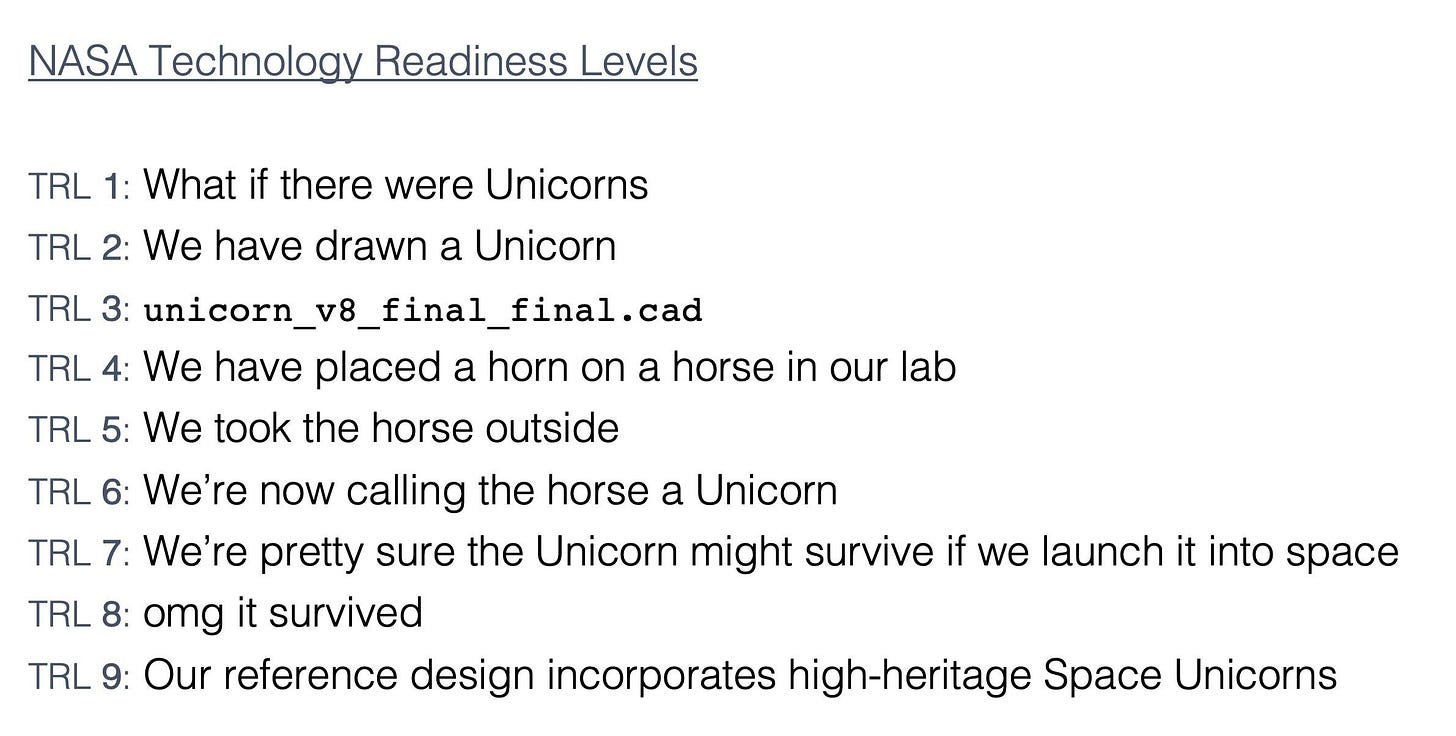When a startup, especially in deep tech, is searching for its first customer, a really important objection to be ready for is a question about the maturity of the technology. The US government has dealt with this a lot, and come up with a framework called a Technology Readiness Level (TRL) to compare and contrast just how mature different concepts and products are.
Not everybody agrees on the definitions of each TRL. The two that I’ve seen the most are the USAF definition and the NASA definition (which I’ll be working with for the rest of this post); there’s some real daylight between them.
Heck, even within an organization, there’s often disagreement about where a particular technology is. In fact, a discussion of exactly this type led Dr. Grant Tremblay to create a graphic about the concept; he calls it “the only mildly popular thing I’ve ever done”.
I love his framing of technology development, and think it works super well for entrepreneurs, because the goal in both cases is quite literally to produce a unicorn. It’s just so elegant!
One of the reasons TRLs are so interesting to firms because they can map technical achievements to business milestones in a way that both other businesses and the government understand. This makes them potentially useful to founders developing an approach to seeking out external funding.
Because TRLs can easily communicate a degree of progress since the last investment, they could very helpful in thinking about when a team might want to raise additional capital. This can be taken even further, and really help craft a narrative for why a team is raising money.
It’s certainly possible to sell an investor on “we have an awesome idea that will change the world when it’s ready, and this funding will help us work on our minimum viable product”. But it’s not easy.
Personally, as an early-stage investor with Dorm Room Fund, I think it’d be a lot more compelling to hear a startup tell a story saying “we have an awesome TRL 2 vision for a world-changing product, and with this funding, we can hit TRL 4 in 6-9 months on a path to hit TRL 8 in a few more years!” This conveys so much more about how far in the R&D process an entrepreneur is, and gives me a better baseline to ask questions about where a startup is in both the process of shipping a product, and figuring out how to make money.
Venture Capital is expensive. Part of what I think it means to be founder friendly, especially to first-time student founders, is to ensure that entrepreneurs are raising for the right reasons, and that the fund I’m a part of can go beyond cutting a check, and connect them with the resources they need to make their moonshot a reality.
TRLs can make those conversations easier to have, and turn more founder visions for paradigm-shifting products into real, live unicorns!



Excellent article Aaron! Thank you for sharing. An interesting challenge for startups is how to balance the urge that most deep tech founders have of focusing on advancing TRL with the other aspects of running a successful business such as Manufacturing Readiness Level (MRL), Integration Readiness Level (IRL), and Business Readiness Level (BRL). For example it does not make sense to do all the work associated with getting to TRL 9 until you have validated the market fit and customer demand. Likewise it would be foolish to do all the customer discovery and line up a long backlog of potential customers if you've not shown that the technology is feasible.
Dr. Sean Ross (AFRL) and Dr. Bruce Cahan (Stanford) have explored this topic extensively and developed a practical guide called the System Readiness Level, that helps companies identify how far along their TRL, MRL, IRL, and BRL should be at each stage. This model ensures that the maturity of each of these factors is consistent with the overall company maturity and helps companies identify where they may be behind or are over-investing.
https://urbanlogic.org/wp-content/uploads/2022/08/Readiness-Levels-Chart-of-Concurrent-Activities.pdf